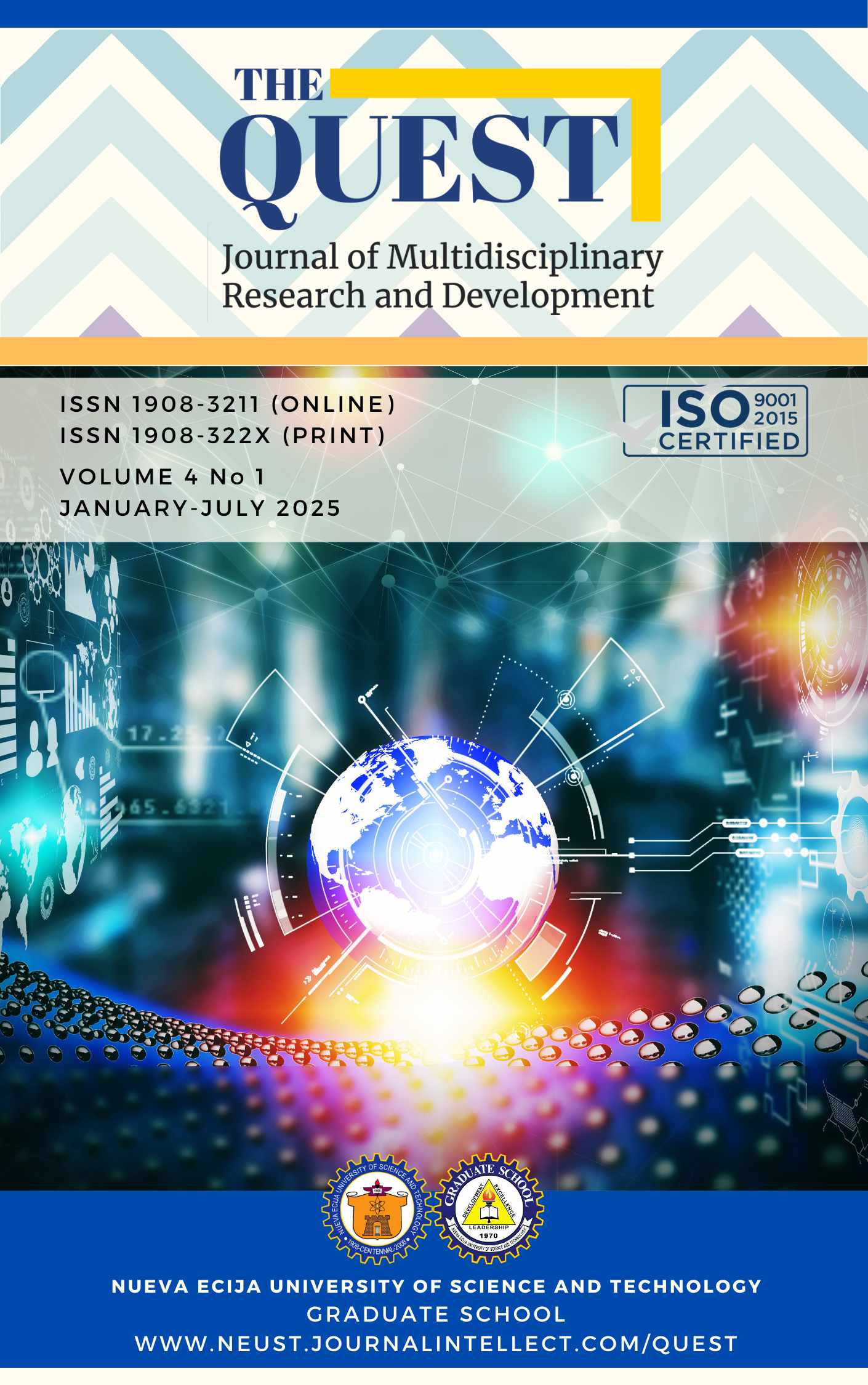Pedagogical Strategies for Online Learning in Public Secondary Schools

Published 06/30/2025
Keywords
- Online learning platform,
- Pedagogy,
- public schools,
- Strategies,
- Teachers
How to Cite
Copyright (c) 2025 The QUEST: Journal of Multidisciplinary Research and Development

This work is licensed under a Creative Commons Attribution-NonCommercial 4.0 International License.
Abstract
This study examines the pedagogical strategies public secondary school teachers employed in Cabanatuan City for online learning. A descriptive survey design was used to gather data from teachers aged 21-30, with females constituting the majority. Most respondents were single and had less than 5 years of teaching experience. The research identified several key pedagogical strategies used by teachers: graphic organizers, self-questioning, cooperative learning, problem-solving and research activities, and mnemonics. Interestingly, the study revealed significant relationships between specific teacher characteristics and certain strategies. Age and sex were linked to the use of graphic organizers and self-questioning. Similarly, teaching experience correlated with the utilization of cooperative learning. Finally, the grade level taught influenced the implementation of problem-solving/research activities and mnemonics. These findings suggest that factors like age, sex, experience, and grade level may influence the choice of online learning strategies. Further research could explore these relationships in more detail. The study highlights the diverse approaches teachers are adopting to engage students in the online environment.
References
- Aggabao, B. A., Aggabao, N., Antiado, D. F., & Castillo, F. G. (2018, March 02).
- Educational Transformation in the Philippine Education System:Towards Global Competitiveness. The International Journal of Business Management and Technology, 2(2), 66-70.
- Colorin Colorado. (2019). Cooperative Learning Strategies. Retrieved from https://www.colorincolorado.orgarticle/cooperative-learning-strategies
- Department of Education. (2020). Official Statement Department of Education. Retrieved From https://www.deped.gov.ph/2020/05/06/official-statement-2
- Dissertation Laerd. (2021). Total Population Sampling. Retrieved from https://dissertation.laerd.com/total-population-sampling.php
- Figley, Marguiles, Stuart and Lewis Eigen. (2012). Applied Programmed Instruction. New York: John Willey and Sons.
- Hilgenheger, N. Die zweidimensionale Darstellungsform der ‘Algemeinen Pädagogik’ J.F. Herbarts. In: Vierteljahresschrift für wissenschaftliche Pädagogik (Bochum), No. 66, 1990, p. 81-94. (English translation in: Education. A Biannual Collection of Recent German Contributions to the Field of Educational Research, Vol. 43, 1991, p. 100-112. Spanish translation in: Educación. Colección Semestral de Aportaciones Alemanas Recientes en las Ciencias Pedagógicas, Vol. 45, 1992, p. 70-83.)
- Lumen Learning. (2020, November 07). Demographic Factors to Consider. Retrieved from https://courses.lumenlearning.com/boundless-communications/chapter/demographic-factors-to-consider/#:~:text=Age%20is%20an%20Important%20Audience,of%20the%20same%20age%20group.
- Lumen Learning. (2021). Sociological Paradigm #3: Symbolic Interactionist Theory. Retrieved from https://courses.lumenlearning.com/alamo-sociology/chapter/reading-symbolic-interactionist-theory/
- Mayol, P. A. (2020, October 5). Cebu Finest. Retrieved from The Paradigm Shift For Teachers’ Challenges In The New Normal: https://cebufinest.com/paradigm-shift-teachers-challenges-new-normal/
- McFarlane, D. A. (2013). Understanding the Challenges of Science Education in the 21st Century: New Opportunities for Scientific Literacy. International Letters of Social and Humanistic Sciences, 35-40.
- Persaud, C. (2021, May 13). Pedagogy: What Educators Need to Know. Retrieved from https://tophat.com/blog/pedagogy
- Presidential Communication Operation Office. (2020). Pantawid Pamilyang Pilipino Program. Retrieved from Philippine Government Official Gazette: https://www.officialgazette.gov.ph/programs/conditional-cash-transfer/
- Queens University of Charlotte. (2021). Effective Teaching Strategies for Elementary School Students. Retrieved from https://online.queens.edu/resources/article/strategies-for-teaching-elementary-students/
- Robosa, J., Paras, N. E., Perante, L., Alvez, T., & Tus, J. (2021, February). The Experiences and Challenges Faced of the Public School Teachers Amidst the COVID-19 Pandemic: A Phenomenological Study in the Philippines. International Journal of Advance Research and Innovative Ideas in Education, 1342-1361. DOI: 10.6084/m9.figshare. 14028833.v1
- Saxena, A. (2020, September 16). The Changing Role of the Educator in the New Normal. Retrieved from Higher Education Digest: https://www.highereducationdigest.com/
- Siniscalco, M. T. (2012). Statistical Profile of the Teaching Profession. Retrieved from http://www.dominiopublico.gov.br/download/texto/ue000105.pdf
- Teacher Vision. (2020). Cooperative Learning. Retrieved from https://www.teachervision.com/professional-development/cooperative-learning
- Ultanir, Emel. (2012). “An Epistemological Glance at the Constructivist Approach: Constructivist Learning in Dewey, Piaget, and Montessori”. Volume 5 No. 2 International Journal of Instruction.
- Wise, M., & Cooper, C. (2019, January 22). Increasing the Value of Graphic Organizers. Retrieved from https://www.edutopia.org/article/increasing-value-graphic-organizers
- Wohlfarth, De De and et.al (2008). Student Perceptions of Learner-Centered Teaching. In Sight: A Journal of Scholarly Teaching, Volume 3.
- Yoshida, H. (2016). Perceived Usefulness of “Flipped Learning” on Instructional Design for Elementary and Secondary Education: With Focus on Pre-service Teacher Education. International Journal of Information and Education Technology, 430-43.
